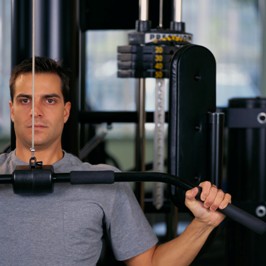Resistance Training for Runners

Generally speaking, there are two primary reasons your weekly training time should include a planned program of weight lifting. First, lifting weights increases the strength of the muscles in the legs and upper body, which makes it easier for runners to manage more intense workloads while actually running. Second, weight lifting is not only good for your skeletal muscles, but it also serves to strengthen all of the connective tissue in the joints. Tendons (connect muscles to bones) and ligaments (connect bones to bones) are the connective tissues that play a crucial role in maintaining joint strength and integrity, and many of the lower body overuse injuries commonly suffered by runners could be significantly reduced if the tendons and ligaments were strengthened.
Several recent studies indicate that only six weeks of weight lifting can significantly reduce or completely eliminate the pain associated with the patella bone in the knee joint, or “runner’s knee”. The strength benefits of weightlifting can also diminish the recurrence of many other common injuries, including hip and low back pain. By increasing major muscle group strength in the legs, hips, and upper body, as well as their associated connective tissues, weight training will aid in both injury prevention and also help to reduce the severity of injury when it does occur.
Consistent weight training has also been shown to improve running performance and lower race times! Studies have shown that twelve weeks of weight training can decrease 10K race times by approximately 1 minute and enhance running economy, which is defined as the amount of oxygen used for a consistent speed of running. Increased running economy will prolong the time to exhaustion for a runner, which will translate into less muscle fatigue in the later miles of a long race, like a half or full marathon.
Designing an Effective Program
Putting together the most effective and time efficient weight training program requires attention to training concepts many runners do not often consider. However, the benefits in running performance are worth the time invested. The key is utilizing a progressive resistance program that incorporates body weight, free weight, and machine exercises. Once a program is designed (see sample program below for an example), the following general guidelines should be adhered to each week:
- Train regularly (at least three days per week). Failure to hit the weights at least three days week each week is not completely ineffective, but the returns on your time investment are greatly diminished.
- Training the muscles on both sides of a joint is highly important for proper balance, strength development, and injury prevention. In other words, when training the legs for example, do both leg extensions and leg curls; both sides of the knee joint.
- To keep improving, a progressive resistance overload must be employed. Once an exercise becomes too easy with the weight you are currently using, it is time to increase the amount of resistance slightly.
- Muscles move a joint through a full range of motion, and it is highly important to lift weights in that same manner. Never compromise range of motion when lifting for additional weight.
- At least 48 hours is necessary recovery time before a muscle or muscle group should be stressed once again. For the best adaptation to occur, the muscles and connective tissue need time to recover from the stimulus of the lifting session.
It is not necessary to have a gym membership in order to begin your resistance training program. Some simple dumbbells and a sturdy bench at home are all that is necessary. You may wish to add a balance ball to more fully train your core. During every exercise pay close attention to your posture, be sure to keep breathing while doing the lifts, and never perform the repetitions too quickly.
Sample Resistance Training Program
Quadriceps, gluteals, hamstrings, and hips: Squat down onto chair or bench, and walking lunges. To make these two exercises more difficult, add weight to your hands by holding the dumbbells.
Calves:Standing heel raises. To make this exercise more difficult, do the raises on a stair step and let your heels fall below the step and/or hold dumbbells in your hands while doing the raises.
Shoulders and upper back: Shoulder shrugs. Try to lift your shoulders up to your ears with dumbbells in your hands.
Back: Dumbbell rows. Put your left knee and left hand on the bench to support your lower back. Let one arm dangle down while holding a dumbbell. Pull the dumbbell up as if trying to start a lawn mower. Make sure to keep your back flat and your arm close to your body as you pull the dumbbell up. Reverse with your other hand.
Chest: Push-ups with your feet up on a chair or bench. Lower yourself until your chest nearly touches the floor. Keep your back straight and your stomach tight.
Biceps: Dumbbell Curls. Stand tall and curl the dumbbells up, one arm at a time.
Triceps: Triceps kickbacks. Same position as dumbbell rows, then extend one arm back with a dumbbell in your hand.
Lower Back: Superman exercise. Lie stomach down, lift your legs, lift your arms straight out in front of you and your neck as if you were flying. Hold the “flying” position for 20 – 30 seconds three times.
For each exercise do 2 – 3 sets of 12 – 15 repetitions. Increase the weight slightly when you are able to complete 15 repetitions on the last set of an exercise. Keep your rest periods between 30 and 90 seconds between sets. Remember to breathe in as you lower the weight and breathe out as you raise or push the weight.
For more information:
Go to the Healthy Weight Center health topic.